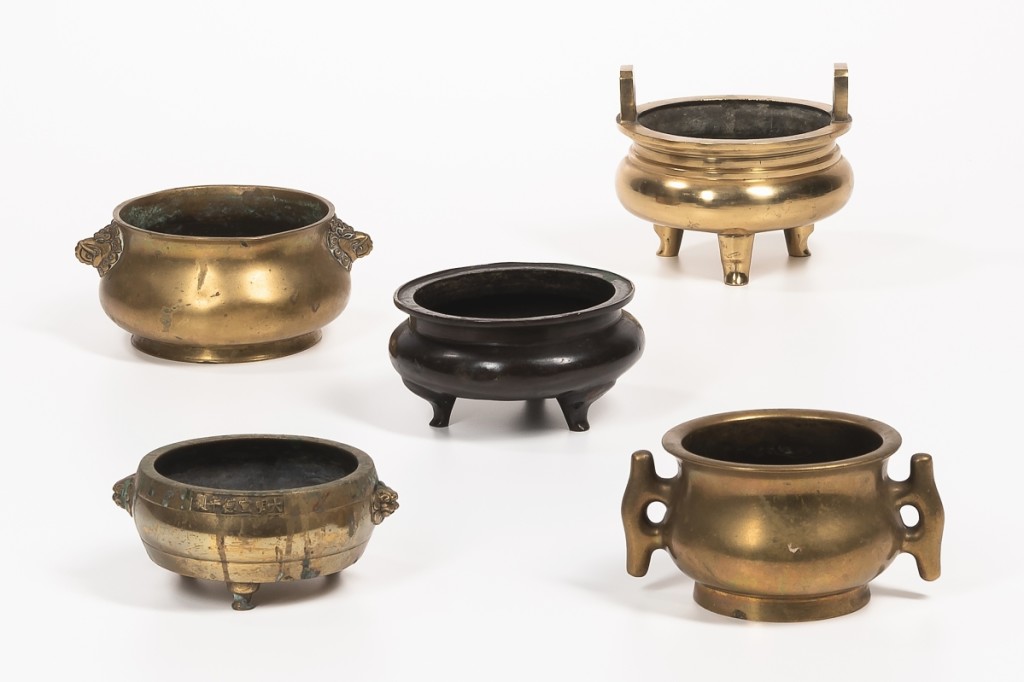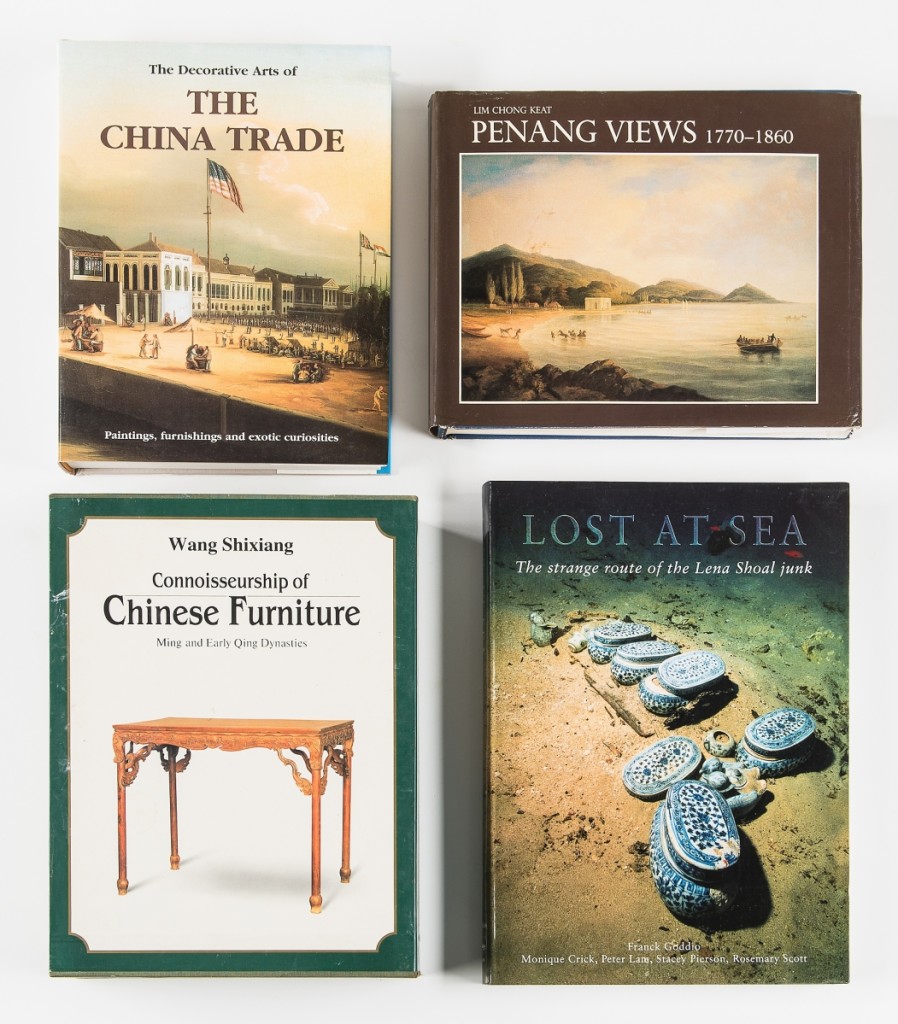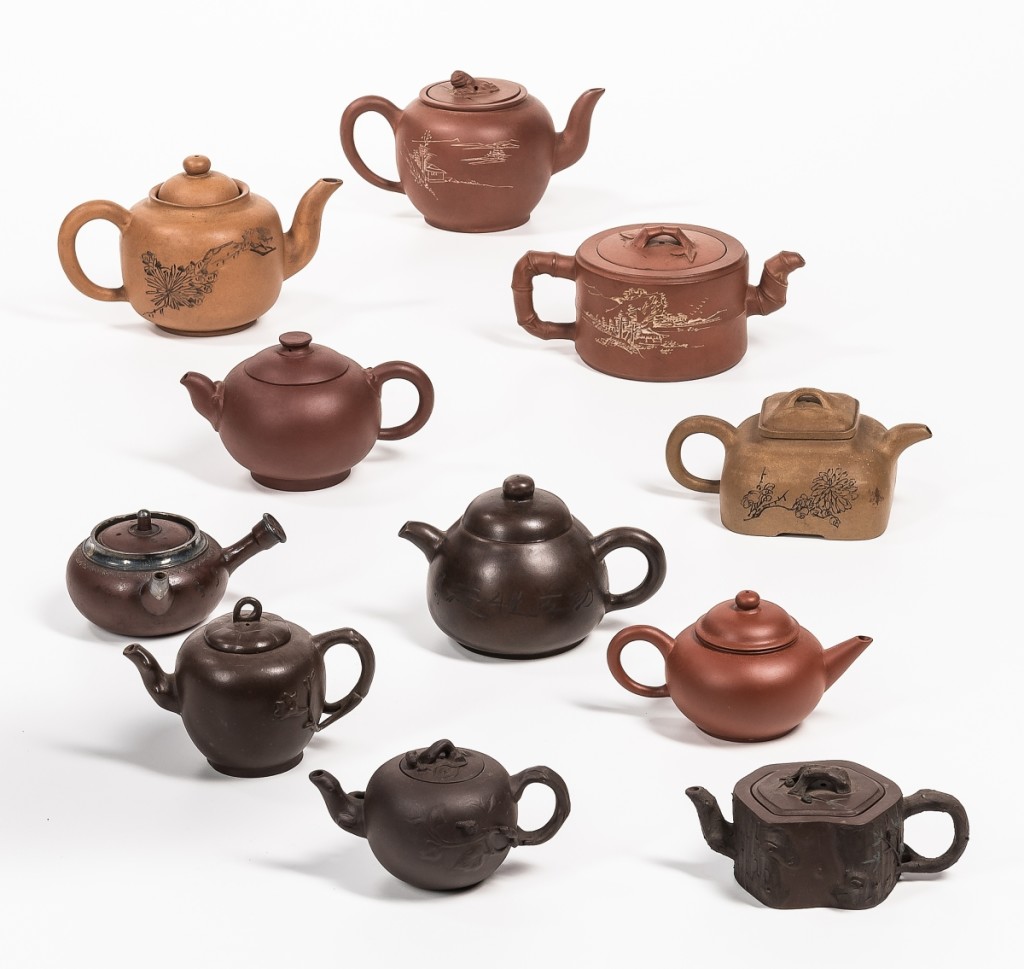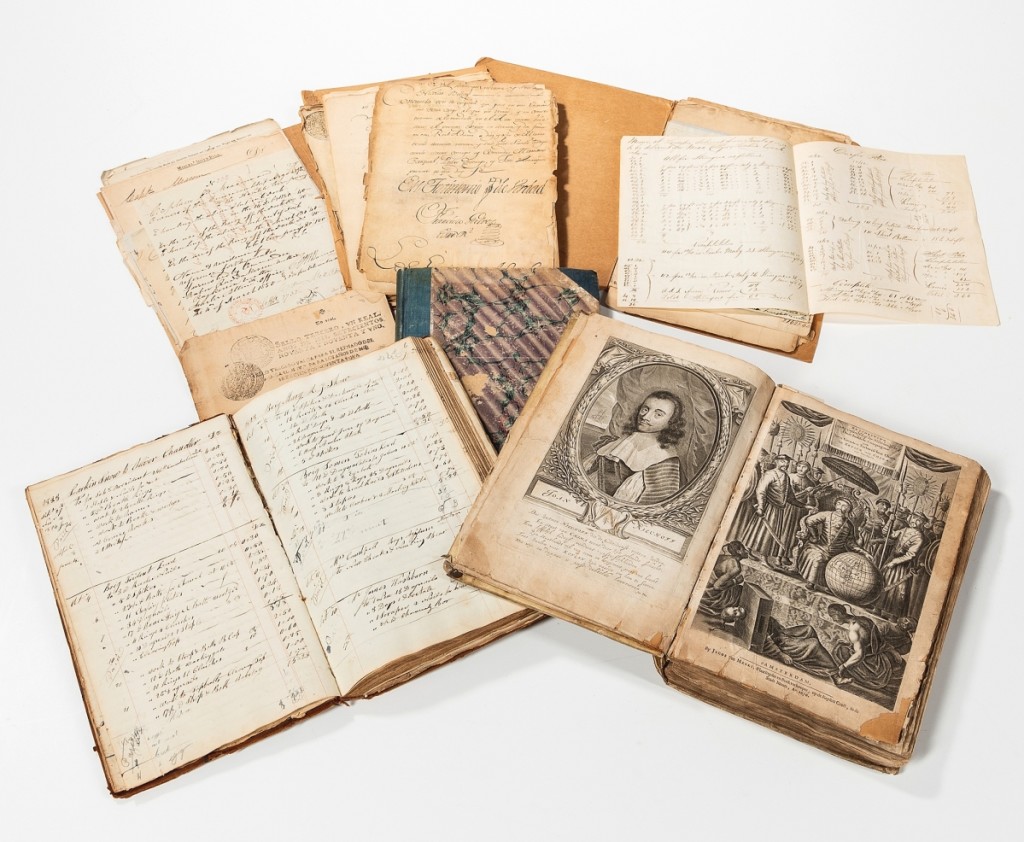
There were not a lot of bronze items in the sale. This group of five Nineteenth and Twentieth Century bronze censers sold for $8,125, far above the estimate.
Review and Onsite Photos by Rick Russack, Additional Photos Courtesy Skinner, Inc.
MARLBOROUGH, MASS. – “They broke the mold when they made Carl Crossman,” said Karen Keane, chief executive officer at Skinner, Inc. One of the first words anyone who knew him would say if asked to describe him would be ‘scholar.’ Other words would include author, teacher, chef, gardener, superb host and many more. Carl was a friend and customer when this writer operated F. Russack Books, which sold out-of-print reference books at shows. When he finished shopping an antiques show, he’d stop by to see if we had any books he might not already own and ask how his books were selling. Invariably, he’d wind up spending time in the booth conversing with anyone who showed any interest in China trade material.
Crossman, who died in 2019, began writing about the China trade nearly 50 years ago, and in 1972 published his seminal work on all aspects of the China trade, The China Trade: Export Paintings, Furniture, Silver and Other Objects, 1785-1865. It became a Book-of-the-Month Club selection and sold out quickly. [For more about Carl Crossman, see Laura Beach’s remembrance of his life, published shortly after his death in the December 17, 2019, edition of Antiques and The Arts Weekly.]
The Skinner sale, January 14-26, which totaled just under $257,000, included numerous examples of blanc-de-chine porcelains, Chinese export porcelains, several lots of Eighteenth and Nineteenth Century European porcelain, furniture, early glass, numerous paintings, including several works by Latin American artists, several examples of the varied curiosities he loved and, most important, his library of reference books and his research notes on the China trade. His level of interest led him to add to his library any book that touched, however tangentially, on the China trade or any other of his many interests. That extensive library would be difficult to assemble these days. There were hundreds of his books in this sale, and Skinner divided them into five large lots which, collectively, sold for just under $30,000, topping by far any other item in the sale.

Crossman’s reference library was sold in large lots. The China trade portion of the library, cataloged as “a large collection of Twentieth and Twenty-First Century books, catalogs and monographs” on the subject, “occupying 55 linear feet of shelf space,” finished at $6,875 and included Crossman’s research files.
Not surprisingly, the China trade books and research material, in two lots, earned $10,500. One lot included a number of Nineteenth Century ledgers of ships involved in the China trade, other handwritten journals, plus about 50 documents relating to trade in the port of Calcutta and other ports. The lot also included a 1670 Dutch book on the Dutch East India Company, plus about 40 engravings of Chinese and English subjects. The bulk of the China trade reference material was sold in a lot that was cataloged as “approximately 55 linear feet of mostly Twentieth and Twenty-First Century printed works on the art, antiques and culture of China and Japan, with Crossman’s research files on the material culture of the China trade.” (As a point of reference, a linear foot of shelf would hold, on average, 11 or 12 books.)
A larger lot, cataloged as “approximately 90 linear feet of mostly Twentieth and Twenty-First Century printed works on American, British and European ceramics, world textiles, silver and American art and decorative arts and culture” realized $10,625. Two other lots contained large numbers of books and all related lots sold well above estimates.
Much, but not all, of the Chinese porcelains were sold in lots of multiple pieces. Getting the day off to a good start was a single, squat, blanc-de-chine censer with applied lion-mask handles. It dated to the Eighteenth or early Nineteenth Century and reached $3,375, well above the high estimate. Blanc-de-chine libation cups were sold in small lots: a group of three pair earned $938 and a group of four with applied decoration brought $813. Yixing teapots were also sold in groups. A lot of 11 Nineteenth Century examples, one of which was trimmed in silver, realized $5,938, more than nine times the estimate.

There were two lots of Yixing teapots. With 11 Nineteenth Century examples, one of which was silver-mounted, this lot sold for $5,938.
Other porcelains, some with defects, included blue and white pieces from both China and Japan, famille rose pieces, Bataviaware pieces and Imari from both China and Japan. Ten Eighteenth and Nineteenth Century famille rose teacups brought $1,000 (one with a large chip), and a group of 22 blue and white Chinese teacups and small plates ended at $2,500. A pair of Twentieth Century famille rose planters, decorated with landscapes in oval panels, with a jurentang mark in iron red, reached $4,688. Crossman’s scholarly interests were apparent with three groupings of ceramics and shards recovered from shipwrecks. One lot included 20 Eighteenth and Nineteenth Century Chinese cups, bowls and plates. It earned $688. A group of about 14 fragments and shards recovered from wrecks sold for $213. Lita Solis Cohen, senior editor of the Maine Antique Digest, told Antiques and The Arts Weekly, “Do you remember how he painted shards on the floor of his house and people would bend down and try to pick them up?” (Yes). She added, “He was a real character with very good taste and loved the stuff.” There were good buys to be had in European porcelains. A lot of 14 Staffordshire silver lustre pieces, including goblets, coffee pots, pitchers and more sold for $469, and nine Jackfield pieces reached $532.
There was much more than books and porcelains in the sale. Furniture included a Japanese metal-mounted black lacquer and gilt cabinet-on-stand. It was decorated with landscape scenes both on the exterior and interior and realized $3,500. Most other furniture was inexpensive. Five small Chinese bronze censers, including both Nineteenth and Twentieth Century examples, brought $8,125, one of the many pleasant surprises of the day. Three of these censers had six-character Xuande marks, one had animal mask handles, and one had a lacquered tripod base. Included in the sale were decorative items and things that Crossman used when entertaining. Four crystal chandeliers included a cast and pressed brass example with eight arms and pendant teardrops, which earned $3,250. A smaller, ten-arm example reached only $375. Clear and colored glassware sold in lots. Nineteen clear tableware pieces brought $750, and a lot of 27 clear pieces, including blown pitchers and decanters earned $1,125.
Crossman’s Florida home had numerous paintings and prints. He had lived in the Caribbean at one point and was partial to colorful works by artists of the Latin American school. An oil on canvas of vegetables by Carlos Collazo-Mattei (Puerto Rican, 1956-1990) realized $2,625, and another, also of vegetables, realized $4,063. A mixed-media on paper of a woman’s head in profile by Joaquín Reyes (Puerto Rican, 1949-1994) reached $2,750. Crossman had his portrait, in formal attire, done by William Kalwick Jr (b 1960). It was signed and inscribed “Kalwick/ Puerto Rico” but sold for only $438.

The China trade reference material included ship’s ledgers and other manuscript items. It also included a copy of a 1670 book on the Dutch East India Company. The lot brought $3,625.
In addition to the quotes from friends used above, there were more. Auctioneer Ron Bourgeault said, “In the 1990s Carl joined us at Northeast and helped with all facets of the business. He was the king of the China trade, having written the definitive book on the subject. In addition, he had knowledge about so many different things, and if he didn’t know about something, he did a quick study. Carl truly had a flair, setting up the auction previews and hosting parties.” Laura Beach added, “I think most of his talent and energy in his later years went to building up the remarkable marine and China trade sales at Northeast Auctions. The sales came and went, but for a decade there was nothing to match them anywhere and they revitalized the entire field.” Speaking for herself and Steve Fletcher, who managed the sale, Karen Keane remembered Crossman as “an author, serious scholar, inveterate collector and generous host. Boston’s Back Bay swells still remember how Carl partied hard with the best of them. Skinner is honored to offer his eclectic collection, which spans 1,000 years and three continents. Included in the auction was Carl’s research library, which offered a chance to secure many important books dedicated to Carl’s never-ending quest to shed light and better understanding on the art and antiques of our times.” Fletcher added, “He knew all subjects and was so very open and willing to share his knowledge. He pioneered the China trade market and was a tremendous influence on the market.” He was also remembered as having been an appraiser on Antiques Roadshow for several seasons.
Prices given include the buyer’s premium as stated by the auction house. For more information, www.skinnerinc.com or 508-970-3000.
































